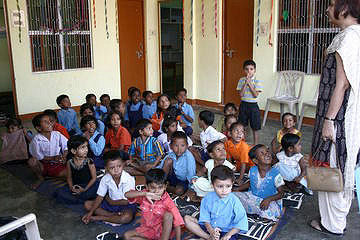
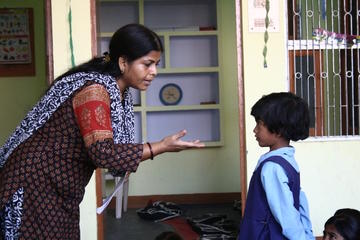
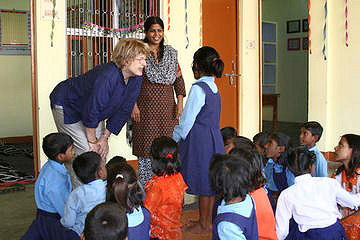
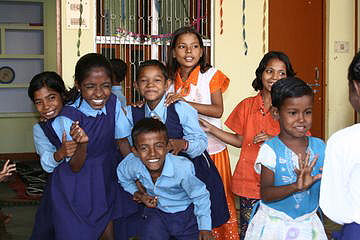
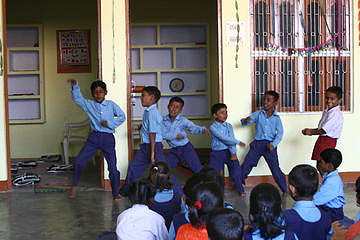
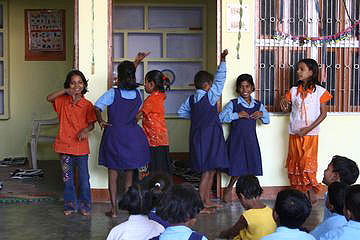
Impressions of DISCCPart 4, Schools14-24 October 2008 |
The next day, we visited the Gangotri School in its new quarters in Nagwa, just south of our hotel at Assi Ghat. Siv and Deepika observed and assisted as Vimla,the teacher, very nicely put into practice what she had learned during the workshop. Afterwards, we were entertained by the children, who recited poems and danced to rhythmic music. They clearly enjoyed letting loose and following the rhythms. Generally speaking, there was an atmosphere of joy and happiness that was striking and that convinced us even more (as if that was needed) of the wonderfully positive role this program is playing in the lives of those children and their families.
We didn't see Manju that day since she's not the English teacher, but Kishun Ji was also present,
the male teacher who seems to be the leader of the dancing activities
which seem so important for the good humor and the motivation of the
students.
 |
 |
| The children and Deepika | Vimla asks the questions |
 |
 |
| Siv joins in | Happy kids |
 |
 |
| Dancing | |
The very young children at Gangotri (3 to 4 years old) obviously could not participate in the English teaching, but Vimla did a wonderful job with the older children who made up one side of the classroom. The same as in Ambedkar school, the children were all seated crosslegged on mats, which is a natural way for Indians, both children and grownups.
Children from both age groups got a chance to recite poems though, and also some things in English that they had learned by heart. One two, button my shoe, three four knock at the door, five six, pick up sticks, etc.
The following day was even more memorable. We all (Tulsi, Deepika, Jean-Max, Françoise, Doortje, Shyamjee, Santosh, Saxena, Siv and I – and maybe others) drove to the village where the Ambedkar School is located and spent 2 or 3 hours there. On the way, we stopped in the middle of the recently constructed bridge south of Varanasi – only in India! – and observed the Ganga flowing peacefully beneath. We also made a traditional stop at a roadside chai stall where we drank – what else? – chai and tasted some sort of vegetable fritters. By now, we were delving more deeply into the life of ordinary Indians. The countryside we drove through was beautiful and green, with well-tended rice fields irrigated by a system of streams and sluices.
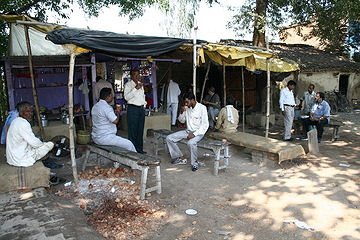 |
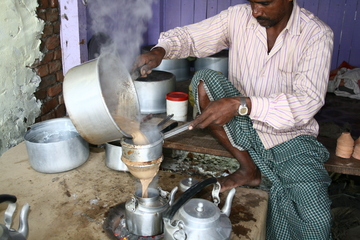 |
| Chai stand | Chai wallah |
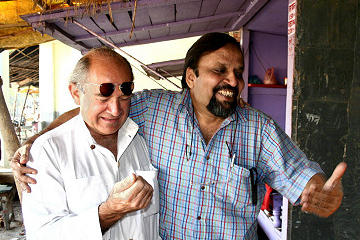 |
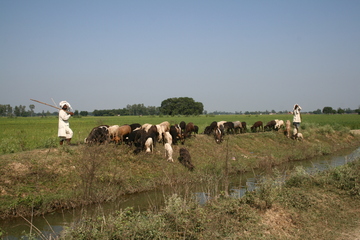 |
| Jean-Max and Tulsi | Fields and goats |
We were greeted at the school by Munilal, who is in charge of the school. Again, Deepika and Siv observed and commented on the teaching of English, and Siv participated some. We toured the village, which was every bit as fascinating as Annapurna, and met Munilal's mother, who was 86.
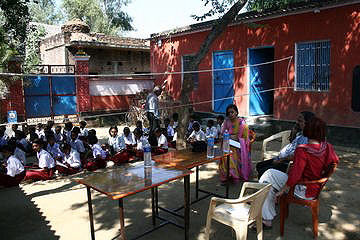 |
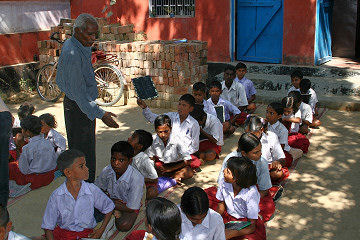 |
| Court of the Ambedkar School | Teacher and students |
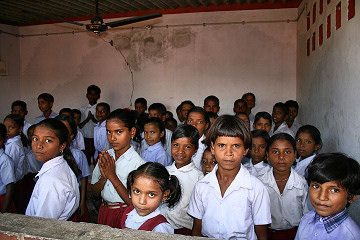 |
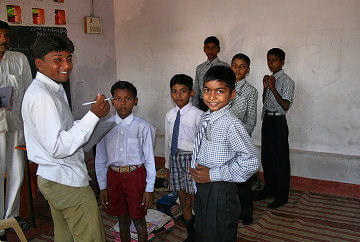 |
| An open classroom | Older CEP students |
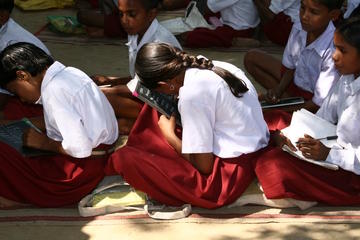 |
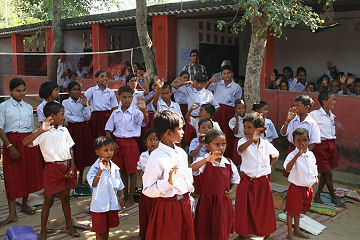 |
| Reading 'n' writing | Children waving goodbye |
Although the school now contains around 150 children, many others would have liked to attend but are needed by their parents to work in the fields. This is a problem that the CEP program in Varanasi must take into account also, in order not to begin financing the education of children who will soon be removed from school by their parents to go selling candles and flowers or begging on the ghats. Nothing is very simple in life, but in India, it seems to us that things are even more complicated than elsewhere.
Before
leaving the
village, we were given garlands of flowers. We also met the village's
spiritual leader, a charming old man in a safran colored robe.
On the way back to
Varanasi, we made another traditional stop at a roadside restaurant
where we ate and talked and made merry with delicious food and
camaraderie. DISCC is not just a serious organization, it's a joyous
one too.
The next day, Siv and
Deepika
repeated the English-teaching workshop for some of the CEP children, of
varying
ages. These are students sponsored by
private individuals in
Siv: I was very interested in seeing what their level would be like. The abilities of the students varied greatly and one or two were extraordinarily shy, but on the whole it was a thrill to see how well they responded to this "new" method of learning English without books or the written word. It made for general amusement when one student, who was extremely shy, couldn't get out the expected answer, and several of the other students fairly screamed out the correct answer. It was altogether a very satisfying experience that left me feeling that this method was definitely an important step forward.
Again, as in the teachers' workshop several days earlier, the general mood was good humor (well, mixed with shyness on the part of one or two girls) and the students were clearly motivated by the ease they experienced in answering my questions. They also seemed to respond extremely well to the general encouraging approach that is essential to learning and central to this method of getting students to speak with ease and with perfect understanding of what they are saying, without constant resort to translation.
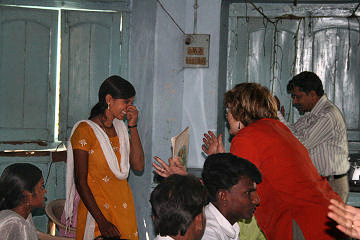 |
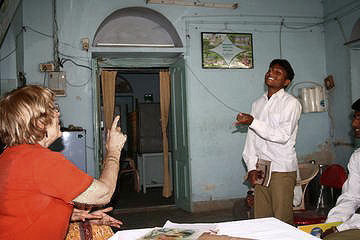 |
| Siv and CEP students do English | |
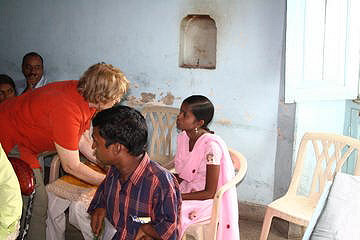 |
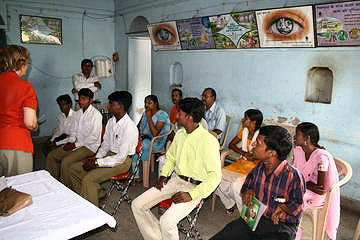 |
Meanwhile, John discussed with Pramendra, Tulsi's programmer, who proposed to develop the DISCC web site himself, using some of our materials and allowing us to correct any English mistakes or typos.
The next day, we flew to Delhi and back home to Genas. But it will be a good while before we forget our visit to Varanasi and DISCC.
Great thanks to Tulsi, Deepika, Jean-Max and all who helped make it a unique and memorable occasion!
Go on to Conclusion: Acceptance, solidarity and uniqueness